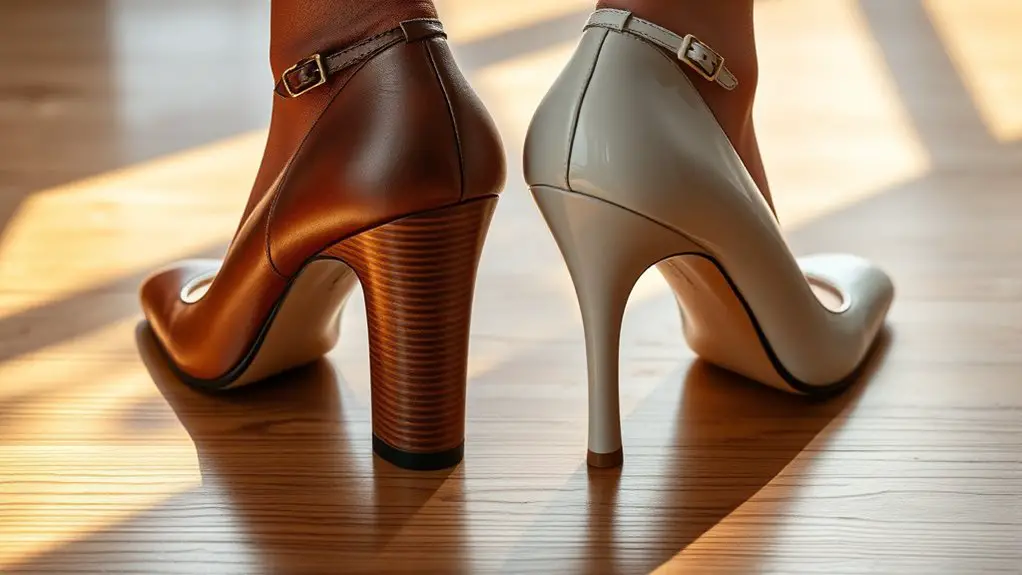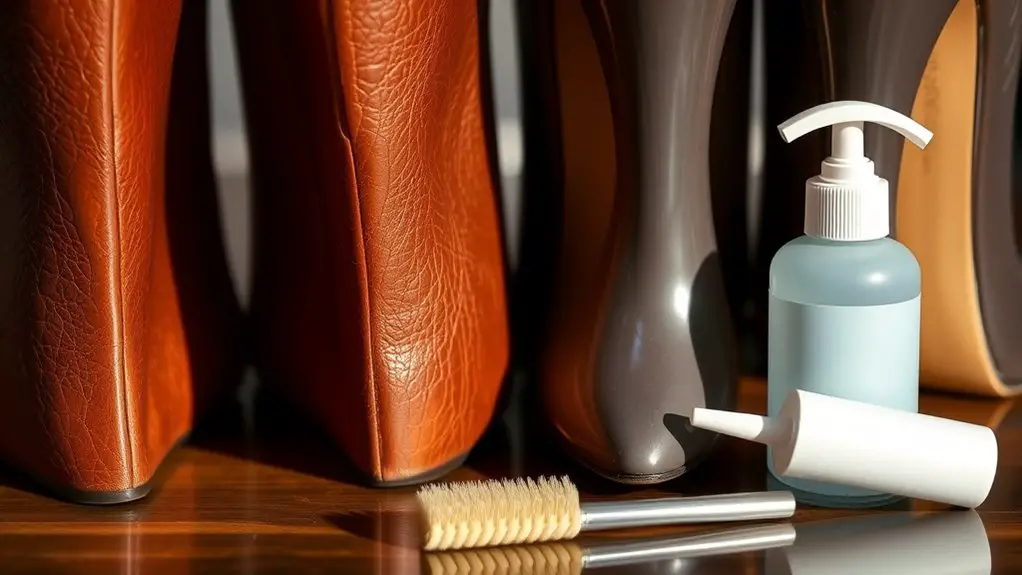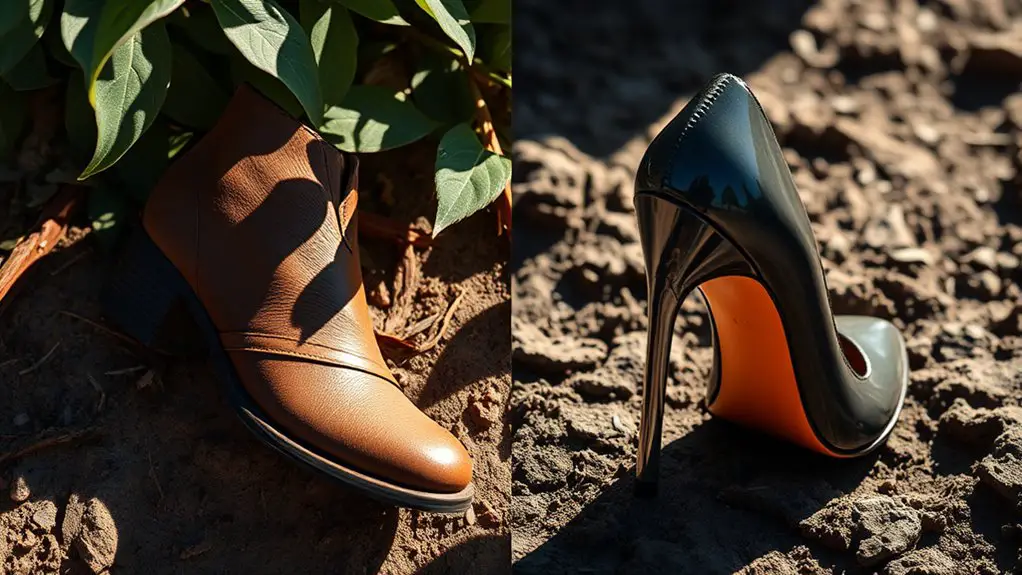When comparing leather and synthetic heels, leather tends to last longer due to its superior durability and ability to develop a rich patina over time. High-quality leather heels resist wear, making them a wise long-term investment. Conversely, synthetic heels may have a lower price point but often require more frequent replacements. While both options have their merits, understanding the nuances can help you make a more informed choice on longevity and overall value.
Understanding Leather Heels: Types and Characteristics

When it comes to footwear, leather heels stand out for their durability and classic appeal. Understanding the various leather types can enhance your decision-making. Full-grain leather is often considered the finest due to its natural look and resilience, while top-grain leather offers a more polished appearance, albeit with slightly less durability. Suede, another popular option, provides a soft texture but may require more maintenance.
Heel characteristics also play an essential role in the overall functionality and style of leather heels. Stiletto heels provide elegance and height but may not offer much comfort for extended wear. In contrast, block heels offer stability and support, making them a practical choice for daily use. Whether you prioritize style or comfort, knowing these leather types and heel characteristics can help you select the perfect pair that meets your needs while ensuring longevity and aesthetic appeal.
Exploring Synthetic Heels: Materials and Features
When considering synthetic heels, you’ll encounter a variety of materials that offer unique benefits. These materials not only impact durability and performance but also include eco-friendly options that address sustainability concerns. Understanding these elements can help you make an informed choice that aligns with your needs and values.
Common Synthetic Materials
Synthetic heels have gained popularity due to their versatility and affordability, often made from a range of materials that mimic the look and feel of leather. Two common synthetic materials used in these heels are polyester blends and polyurethane options. Understanding their characteristics can help you make informed choices.
| Material | Features |
|---|---|
| Polyester Blends | Lightweight, durable, and easy to clean. Often used for stylish designs. |
| Polyurethane Options | Flexible and water-resistant. Provides a leather-like texture while being cost-effective. |
These materials allow for a variety of styles and price points, making synthetic heels an appealing choice for many. By knowing these common materials, you can find options that suit your lifestyle and preferences.
Durability and Performance
Durability is an essential factor to take into account when evaluating synthetic heels, as it directly impacts their performance over time. Various durability factors come into play, such as the quality of materials used, construction techniques, and resistance to wear and tear. For instance, high-grade synthetic materials like polyurethane are designed to withstand daily use and maintain their shape. Performance metrics, including grip, flexibility, and comfort, can also be affected by these materials. You might find that synthetic heels often provide a lightweight feel, which enhances comfort during long wear. However, it’s important to assess how these factors align with your specific needs, ensuring you’re making an informed decision when choosing synthetic over leather options.
Eco-Friendly Options Available
Although traditional leather options have long been favored for their luxury and longevity, eco-friendly synthetic heels are gaining traction as sustainable alternatives. Many eco-friendly brands are now utilizing sustainable materials like recycled plastics, organic cotton, and innovative bio-based materials. These options not only reduce environmental impact but also often come with features like water resistance and breathability. By choosing synthetic heels from eco-conscious brands, you’re supporting a movement towards greener fashion. Additionally, these materials can mimic the look and feel of leather without the associated ethical concerns. As you explore your choices, consider how opting for sustainable synthetic heels can align your style with your values, making a positive contribution to environmental sustainability.
Durability Comparison: Leather vs. Synthetic
When comparing the durability of leather and synthetic heels, it’s essential to evaluate their material composition and how it affects wear and tear resistance. Leather typically offers a more robust and long-lasting option, but it requires careful maintenance to retain its quality. In contrast, synthetic materials often withstand daily use with less care, but they may not have the same longevity as leather.
Material Composition Impact
In the debate between leather and synthetic heels, the material composition greatly influences their durability. Understanding the distinct material properties can help you determine which option offers better longevity factors. Here are some key points to evaluate:
- Breathability: Leather provides natural airflow, reducing moisture accumulation.
- Flexibility: Leather can mold to your foot over time, enhancing comfort.
- Water Resistance: Synthetic materials often offer better waterproofing, protecting against spills.
- Scratch Resistance: Synthetic heels tend to resist surface damage more effectively than leather.
- Maintenance Needs: Leather requires regular care to maintain its durability, while synthetics are generally easier to clean.
Wear and Tear Resistance
While both leather and synthetic heels offer unique benefits, their wear and tear resistance can greatly impact your choice. Leather, known for its natural fibers, generally provides excellent wear resistance and tear strength, allowing it to withstand daily use over time. It tends to age gracefully, developing a patina that some find appealing. However, it can be susceptible to water damage if not treated properly.
On the other hand, synthetic materials, often engineered for durability, can also exhibit impressive wear resistance. They’re typically more resistant to moisture and stains, making them practical for various environments. Yet, their tear strength may not match that of high-quality leather, potentially leading to quicker deterioration under heavy use. Ultimately, your lifestyle and preferences will guide your decision.
Maintenance and Care Needs
Although both leather and synthetic heels require maintenance, their care needs differ considerably. Leather tends to demand more attention, while synthetic materials often need less upkeep. Here are some essential maintenance tips for both types:
- Cleaning Techniques: Use a damp cloth for synthetic heels; leather requires specific cleaners.
- Conditioning: Leather needs regular conditioning to prevent cracking; synthetic doesn’t.
- Storage Tips: Store leather in a cool, dry place; synthetic can be stored in a variety of conditions.
- Water Resistance: Apply waterproofing solutions to leather; synthetic generally resists moisture better.
- Repairs: Leather can be repaired professionally; synthetic often cannot be fixed once damaged.
Understanding these differences helps you maintain your heels effectively, ensuring longevity for your favorite pairs.
Maintenance and Care for Leather Heels
Caring for leather heels is fundamental if you want to maintain their appearance and longevity. Regular maintenance helps prevent damage and prolongs their life. Employing proper cleaning techniques is essential; gently wipe them with a damp cloth to remove dirt and dust. For deeper cleaning, consider using a leather cleaner specifically designed for your shoe type.
Additionally, conditioning products are significant for keeping the leather supple and preventing cracks. Apply a leather conditioner periodically to maintain moisture.
Here’s a concise table summarizing key maintenance practices:
| Maintenance Task | Frequency | Recommended Products |
|---|---|---|
| Clean with cloth | After use | Soft cloth |
| Deep clean | Monthly | Leather cleaner |
| Condition | Every 3 months | Leather conditioner |
| Protect from water | As needed | Water-repellent spray |
| Store properly | Always | Shoe trees or dust bags |
Maintenance and Care for Synthetic Heels

Synthetic heels require a different approach to maintenance and care compared to their leather counterparts. Understanding how to care for synthetic materials will help extend the life of your footwear. Here are some effective cleaning techniques to keep in mind:
- Wipe Down: Regularly use a damp cloth to remove dirt and dust.
- Mild Soap: For stubborn stains, use a mixture of mild soap and water; avoid harsh chemicals.
- Drying: Let your heels air dry away from direct sunlight to prevent warping.
- Storage: Keep them in a cool, dry place, ideally in a dust bag, to avoid scratches.
- Conditioning: Use a synthetic-friendly conditioner occasionally to maintain flexibility.
Comfort and Fit: Leather vs. Synthetic
When considering comfort and fit, the choice between leather and synthetic heels can greatly impact your overall experience. Leather typically molds to your foot shape over time, providing a customized fit adjustment that many find enhances comfort levels. In contrast, synthetic materials often lack this adaptability, leading to potential discomfort during prolonged wear.
| Feature | Leather Heels |
|---|---|
| Fit Adjustment | Molds to foot, offers personalized fit |
| Comfort Levels | Generally higher over time |
| Feature | Synthetic Heels |
| Fit Adjustment | Limited flexibility |
| Comfort Levels | Varies, may be less than leather |
Ultimately, your choice may depend on how you prioritize immediate comfort versus long-term fit adjustment. Experimenting with both materials can help you find the best option for your needs.
Environmental Impact: Sustainability Considerations

As you weigh your options between leather and synthetic heels, it’s essential to evaluate their environmental impact and sustainability. Each material has its own set of considerations when it comes to eco-friendly practices and sustainable materials.
Here are some key points to reflect upon:
- Leather: Often sourced from animal hides, the production process can involve significant water and chemical use.
- Synthetic materials: Typically made from petroleum-based products, contributing to fossil fuel dependency.
- Durability: Leather tends to last longer, potentially reducing waste over time.
- Recyclability: Many synthetics are less recyclable, leading to landfill concerns.
- Animal welfare: Leather production raises ethical questions regarding animal rights.
Cost Analysis: Long-Term Investment
While the initial purchase price of heels can vary considerably between leather and synthetic options, it’s important to evaluate the long-term value each material offers. Leather heels often come with a higher upfront cost, but their durability can lead to greater investment longevity. When properly cared for, leather can withstand wear and tear, potentially lasting for years, making it a more cost-effective choice over time. On the other hand, synthetic options usually have lower price tags, but they may not hold up as well under frequent use. This can lead to more frequent replacements, ultimately compromising their cost effectiveness. When calculating the true cost of your heels, consider not just the initial price but also how long you expect them to last. A well-made leather pair may require a larger initial investment but could save you money in the long run, ultimately influencing your purchasing decision.
Personal Preferences: Choosing What’s Right for You
How do personal preferences influence your choice between leather and synthetic heels? Your decision often reflects your unique style and comfort preferences. Understanding these factors can help you select the right pair for any occasion. Consider the following aspects:
- Aesthetic Appeal: Leather offers a classic, timeless look, while synthetic materials can provide bold, trendy designs.
- Comfort Level: Leather often molds to your feet over time, providing a custom fit; synthetics may feel comfortable right away but can lack breathability.
- Maintenance: Leather requires regular care, while synthetic heels are typically easier to clean and maintain.
- Environmental Impact: If sustainability is important, you might lean towards synthetic options that are more eco-friendly.
- Budget: Your price range can greatly affect your choice, with leather generally being more expensive upfront.
Ultimately, it’s about finding the perfect balance between style and comfort that suits your lifestyle.
Frequently Asked Questions
Can Leather Heels Be Repaired if Damaged?
Imagine a beloved book, its spine worn but still cherished. Just like that, leather heels can often be repaired using various techniques. Regular leather maintenance helps guarantee they remain a stylish option for years to come.
Do Synthetic Heels Provide Better Traction Than Leather?
When considering traction performance, synthetic heels often outperform leather due to their material durability. The rubber compounds used in synthetic designs typically offer enhanced grip, especially in wet conditions, making them a practical choice for stability.
Are There Vegan Alternatives to Leather Heels?
Yes, there are vegan alternatives to leather heels, including options made from sustainable materials like cork, recycled plastics, and microfiber. These eco-friendly options not only reduce environmental impact but also offer stylish choices without compromising ethics.
How Do Weather Conditions Affect the Lifespan of Heels?
Weather can be quite the trickster, affecting your heels’ lifespan. Seasonal durability varies; moisture can weaken materials, while extreme heat can warp them. Understanding weather impact helps you choose wisely for longevity and style.
What Are the Best Brands for Durable Heels?
When considering the best durable brands, focus on those known for quality craftsmanship. Brands like Clarks, Sam Edelman, and Nine West often excel in heel quality comparison, providing longevity and comfort without compromising style.



